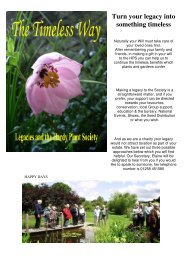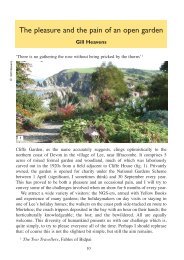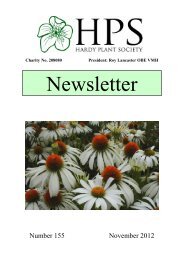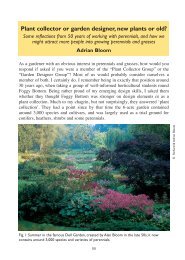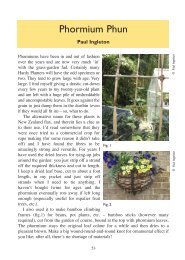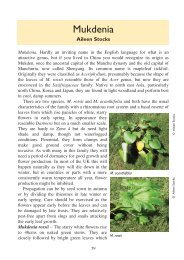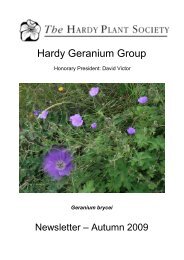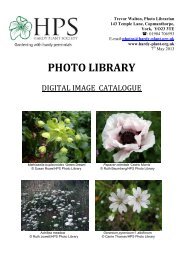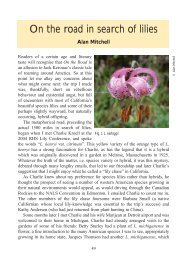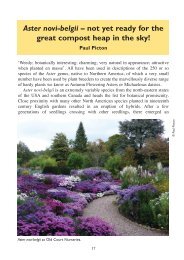A little ridiculous - Hardy Plant Society
A little ridiculous - Hardy Plant Society
A little ridiculous - Hardy Plant Society
You also want an ePaper? Increase the reach of your titles
YUMPU automatically turns print PDFs into web optimized ePapers that Google loves.
A <strong>little</strong> <strong>ridiculous</strong><br />
Martin Spray<br />
‘Little things, <strong>ridiculous</strong> things’, wrote the English poet Edward Shanks, ‘shall<br />
move me to smiles or tears or verse.’ 1<br />
Jane and I have just returned from a local nursery with a box of plants<br />
including Helleborus foetidus, Lathyrus latifolius, Geranium x magnificum, and<br />
Caryopteris x clandonensis. I mention this first, in the hope that it will help counter<br />
any impression that I shun plants unless they are all-green (or brown), and have<br />
obscure <strong>little</strong> flowers (or none).<br />
It is glaringly obvious that some types of plant are persistently popular. <strong>Plant</strong>s such<br />
as rose and narcissus: in the 2006-07 <strong>Plant</strong> Finder there were respectively 27 and 13<br />
pages of them. Their reputation for beauty is long established. In the same tome there<br />
are nearly a hundred forms of Miscanthus sinensis, and it has only recently come over<br />
the horizon – in the first <strong>Plant</strong> Finder, of 1987, there were seven – but it seems it has<br />
already become quite widely appreciated. Or... is it just part of an ornamental grass<br />
fashion, to fade away in the shadows while the Old Favourites continue in the<br />
sunshine? Certainly, grasses are very unlike roses, and their beauty seems to come as<br />
an acquired taste rather than a ‘given’. And yet....<br />
I do not doubt that there are features of – for example – Rosa and Narcissus that<br />
make them almost universally attractive, even though I’m not sure why I myself don’t<br />
find either especially captivating! I also wouldn’t dispute the ‘acquired taste’ factor<br />
involved in calling Eulalia grasses ‘beautiful’; and I suspect a ‘Jones’s’ factor is helping<br />
their sales figures. Yet roses in particular stay popular partly for sentimental reasons.<br />
Yet isn’t there something beautiful to be found in any plant, though you may not<br />
notice/find/look for it? Of course, like people, some are more beautiful than others;<br />
indeed, with some (as with people) one must look carefully and closely to see their<br />
beauty. But the looking can be well rewarded. I have tried to write about this before 2 .<br />
In spite of humankind’s efforts to make the world an ugly place (so it seems),<br />
there is plenty of beauty around – but some of it is subtle. Some is very subtle.<br />
However, some is blatant, but we either can’t see it or we ignore it because of<br />
other, less desirable, features it comes with. Does any plant flower more beautifully in<br />
your garden than the Taraxacum defiantly rooted in the path or lawn? I, too, have far<br />
(far) too many of this particular Good Thing; yet, like some other gardeners, I tend to<br />
have regrets when spudding them out 3 .<br />
1 Edward Shanks Sonnets on separation vi, from Poems, 1916.<br />
2 I think it started with A meditation on Death, in Vol.13 (1991), but I want to follow on from the end of<br />
Subtle Obscurities and Knotty Problems, in Vol. 29 No. 1 (2008).<br />
3 Febrin LePadden wisely admires them as pot-plants (Containing the wild Vol. 28 No. 1). Febrin, you<br />
are not alone in enjoying all plants without distinction – though I bet you, too, have favourites.<br />
63
‘Dandelion’ is not a very precise name. There are maybe 250 named species in<br />
Britain 4 . Your garden may have many different ones. The differences between them<br />
are subtle to say the least, and few experts can tell them apart. Maybe someone is<br />
busy growing a collection of them all. Would that be one step closer to fanaticism<br />
than, say, collecting ferns or cultivars of Sempervivum: a devotion to subtlety? Are<br />
they not all beautiful in flower?<br />
This is all about subtlety, so ferns may be a good case to point to. I have had a<br />
fondness for them since childhood, when I learned to make ‘dinner plate’<br />
gardens of moss, infant ferns, and small stones. It is frustrating but amusing to<br />
look around plant centres and even nurseries, and find things labelled with no more<br />
than ‘hardy fern’, presumably because they are thought to look so alike. Yes: like<br />
people, many are quite like each other; but as you come to know them, they become<br />
recognisably distinct. More or less. Amongst a group of Dryopteris affinis and filixmas,<br />
native ‘male’ (buckler) ferns, and a few of their varieties, I have planted a single<br />
D. dickinsii. I need to find its label. Why? Because without that, I can’t tell which it is.<br />
And of course, these plants don’t have those identification features we so heavily rely<br />
on: flowers. One has to work at getting to know them. My point is it is worth doing<br />
so, even if you can’t remember who you are peering at. It is pleasing when I find<br />
someone who enjoys our fernery, and slightly frustrating when others don’t – ah well,<br />
chacun à son gout… To the keenest ones, I show a small tuft of green hair in the<br />
dampness under the rainwater tap: a dinky horsetail, Equisetum scirpoides. Even I<br />
keep forgetting it’s there.<br />
It’s also a pleasure to find that a visitor shares an interest in Hedera helix – the<br />
common ivy. Common it may be, but how varied! I keep browsing the Fibrex<br />
catalogue, which lists over a hundred varieties, wondering where to fit in a few more.<br />
But look no further than the leaves of ivies in the wild, varying from site to site, plant<br />
to plant, and node to node. The diversity of shape is fascinating; but how often do we<br />
notice such details? Outside the kitchen door is a selection of cvs ‘Anita’, ‘Ferney’,<br />
‘Duckfoot’ and ‘Tripod’, and a couple of ‘wild’ specimens, all in a 30cm pot; all<br />
greens, and not a flower in prospect.<br />
I do like flowers. Mibora minima is a rare native of Britain’s sand-dunes. I<br />
acquired a few seeds forty years ago, and my father kept a tiny colony ‘ticking over’<br />
in a corner of a raised heather bed for twenty years or more, by which time I had<br />
established two even smaller colonies – on a wall-top and in a greenhouse pan – in<br />
my own garden. I neglected the pan, and the wall-top crevices filled up with<br />
advancing sempervivums. Mibora is an ephemeral – it grows for a few weeks,<br />
flowers, and dies. Commonly about 3cm tall in flower, ‘inconspicuous’<br />
overemphasises its presence.<br />
Another favourite I acquired about the same time is a bit of a thug, soaring to 3 m<br />
4 So-called apomictic species, in which seeds develop without fertilisation.<br />
64
efore it flowers, and dies. Heracleum mantegazzianum, the giant hogweed, is now<br />
on the Wanted Dead or Alive list, and I’ve been persuaded to stop growing it.<br />
I miss both plants. I miss the dainty subtlety of the one and the almost manic<br />
exuberance of the other. One might say that ‘minima’ refers to the sand-grass’s<br />
impact; its admirers wouldn’t. Heracleum, of course, is Herakles, a.k.a. Hercules – a<br />
name not quite so apt for the British native H. sphondylium! I am sometimes<br />
reminded that both parts of the name hog-weed are apt, and that quite a few other<br />
plants are more attractive/flamboyant/interesting/docile; but I still like them.<br />
Gardeners tend to keep too stark a boundary between ‘weed’ and ‘wanted’. Have<br />
you managed to rid your garden of Cardamine hirsuta, the hairy bittercress? Nor<br />
have I. It’s an annoying (rather than noxious) weed, which we try to keep at bay at<br />
least in the vegetable area. In a few situations, though, I welcome it – in modest<br />
quantity, and for a short period early in the year. It has a nice habit of flowering very<br />
early, as tiny plants, amongst the pads of moss on the top of a breezeblock wall, just<br />
below eye-height. This habitat in summer is a ‘forest’ of the short, annual, fern-grass<br />
Catapodium rigidum, well worth a close-up glance, en passant. But I probably give this<br />
habitat most attention (still, I admit, not a huge amount) very early in spring, when<br />
passing the wall brings me face-to-face with a sort of landscape-in-miniature, growing<br />
drought-tolerant mosses, stonecrop, tiny red rosettes of herb Robert (Geranium<br />
robertianum) and fresh green ones of its cv. ‘Celtic White’. This lilliputian scene is<br />
enlivened by the minuscule, bright, simple white flowers of the despised hairy<br />
bittercress. And I mean mini: the petals are at most 3mm. 5<br />
Would it not, in this situation, be better called fairy bittercress? I must admit my<br />
attention is soon diverted to the rich pink, short-lasting Cardamine pentaphylla; then<br />
to white, long-lasting C. trifolia, also in shade in the fernery; and then to the swarms<br />
of pale pink and occasional white ladies’ smocks, C. pratensis, sharing parts of the<br />
rough grass with the paigles 6 for several weeks from early April. I admit all of them<br />
cheer me as I wander around the garden, and of course these perennial species are all<br />
in a class beyond the dreams of <strong>little</strong> hirsuta. Yet still that annoying <strong>little</strong> weed, in the<br />
dawn of the year, has enough charm to make it worth stopping for. As the ladies’<br />
smocks fade, another Cardamine becomes noticeable – in a quiet way. The narrowleaved<br />
bittercress, C. impatiens, is a visitor from a wet part of the adjacent forest,<br />
which fills up some disturbed soil in light shade. I like its rather distinctively spiky,<br />
upstanding, ferny foliage, lighter green than the surrounding plants. The population<br />
growing here usually has no petals.<br />
Gardeners grow what they grow for a variety of reasons, by no means primarily<br />
– let alone only – for how the plants look. Take H. sphondylium, the wild<br />
hogweed. Aesthetically it is a poor shadow of H. mantegazzianum, but I like the<br />
5 There are also petal-less forms. This New Zealand migrant sometimes grows no leaves and but a<br />
single flower.<br />
6 Oxlips, Primula elatior.<br />
65
effect – a fairly subtle one – of a handful of each of its green-stemmed and purplishstemmed<br />
forms growing together in the company of a tall, woolly, late-flowering,<br />
wildling mint. But I grow it mainly because an impressive diversity of insects find the<br />
blossoms attractive, including moths and butterflies that we find attractive, at a time<br />
when other sources of nectar are waning. Is that not sufficient reason?<br />
When it is time to decapitate the hogweeds to preclude a take-over, the subtly<br />
bluey-mauvey-grey mint 7 is the most popular thing in the garden with later autumnal<br />
butterflies, wasps, beetles and flies. Those last butterflies are especially delightful,<br />
though their colours are outdone by some of the beetles and flies. Have you watched<br />
flies feeding? Few are flamboyant, but some are bright as jewels. About the brightest<br />
are greenbottles; and because the Forest of Dean is sheep country, there are plenty<br />
around here – unfortunate for the sheep, because greenbottle maggots are flesh-eaters.<br />
Such is the reality of ecology. It does not stop the flies being beautiful visitors.<br />
We are spoiled for choice, and dazzled by the fizz and flamboyance of all that<br />
choice. In his fascinating 400-year history of an English garden 8 , George Ordish<br />
imagines how one of its earlier occupants might have scoured the local<br />
countryside for unusual forms of wild violets, to dig up and grow together. Doubtless,<br />
if she had had access to even a thousandth of the contents of The <strong>Plant</strong> Finder, she<br />
would have scorned common violets. Yet, while we are eagerly eyeing the subtlest<br />
difference between Inyorfacia florida (!) varieties ‘Brightest of All’ and ‘Brighter<br />
Still’, and wondering if we should get the new ‘Brighter than Brightest’, the<br />
rumbustious dandelions, the humble violet, the common ivy, the hard-to-distinguish<br />
ferns, and even the bemoaned bittercress, are (still) subtly enriching the world.<br />
Take a hint from the poet: ‘I’ll see the flowers /and <strong>little</strong> things, <strong>ridiculous</strong> things,<br />
shall move me / to smiles or tears or verse.’<br />
Martin Spray shares a garden in the Forest of Dean with his wife, who<br />
would like to see a lot more proper flowers in it and fewer ever-brown New<br />
Zealand sedges. Martin is an editor of Ecos, A review of conservation, and used<br />
to teach environmental ethics.<br />
The leaves are from ivies climbing eleven adjacent pines in The Delves Inclosure,<br />
Brierley, in the Forest of Dean – true ‘biodivyrsity’<br />
7 I wouldn’t dare to offer a name. One of my long-ago tutors, Mike Harvey, wrote that only ten Mentha<br />
species are recognised in Europe, ‘but in the Index Kewensis the names of over 900 species and hybrids are<br />
listed, chiefly from Europe. The majority of these are worthless, but it would be a life’s work to reduce<br />
them to order.’<br />
8 George Ordish The living garden, London, 1985.<br />
66



